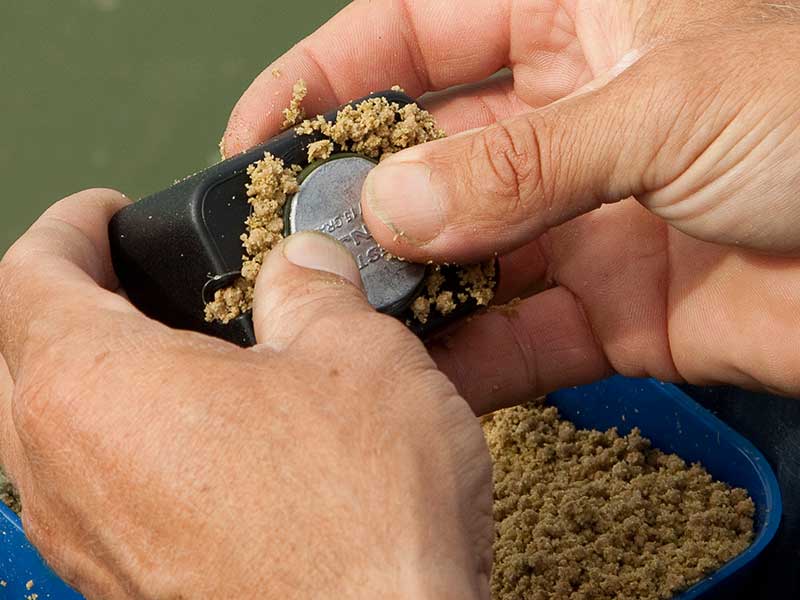Fin helps you bring the Banjo into play
Share the Fin helps you bring the Banjo into play article:
Delen
Want to improve your Banjo Feeder fishing? What better person to give you a masterclass than the inventor – Andy Findlay
Fishing with a Banjo Feeder is extremely easy and it can be done by anyone, but fishing it effectively is another ball game. I’m going to run through a few tips to help you get the best from this superb approach.

load a banjo feeder
 1. Fill the bottom of the mould with your dampened pellets
1. Fill the bottom of the mould with your dampened pellets
 2. Make an indentation in the pellets for your hookbait, add more pellets to the mould and place the feeder in.
2. Make an indentation in the pellets for your hookbait, add more pellets to the mould and place the feeder in.
 3. Push the release button on the bottom to release the feeder from the mould
3. Push the release button on the bottom to release the feeder from the mould

1. Pick your size
Picking the right size is essential. Most of my Banjo Feeder fishing is done in the late spring and winter. I feel that this is a time when it is far more effective than the Method. It’s an ideal way of catching fish which are wary of a bombardment of feeders, so creating minimum disturbance is key. Choose the lightest feeder you can get away with for the distance. I’ll start with a small feeder, but if the fish are in the mood for a bit of grub I’ll happily swap to a large feeder.
2. Balance your tackle
A high percentage of commercial fisheries are fairly small meaning a cast of 50 yards will most likely cover any cast you need to make. I use a Innovations C-Tech 11/13ft Feeder rod.

 The through-action of this rod absorbs any lunges that a fish may make at the net and it has the power to cast longer distances if needed! This is matched with a PXR- Pro 4000 Reel. The 4000 size matches well with this rod when used at 11ft or 13ft and is loaded with 6lb Power Max Reel Line. The long cast spool means the line has little memory when it leaves the reel, making for effortlessly smooth casts. If extreme distance is required I will think nothing of stepping up to a 5000 or even 6000 sized reel to make fishing at distance easier.
The through-action of this rod absorbs any lunges that a fish may make at the net and it has the power to cast longer distances if needed! This is matched with a PXR- Pro 4000 Reel. The 4000 size matches well with this rod when used at 11ft or 13ft and is loaded with 6lb Power Max Reel Line. The long cast spool means the line has little memory when it leaves the reel, making for effortlessly smooth casts. If extreme distance is required I will think nothing of stepping up to a 5000 or even 6000 sized reel to make fishing at distance easier.
 3. Accuracy is everything
3. Accuracy is everything
Casting accurately is a must when fishing the any Feeder, especially when fish are harder to catch. When they arrive in your peg you’ll want them concentrated into one area. This means that your casting has to be consistently accurate. Now I don’t want to be boring, but practice does make perfect. This is a great time to practice for a number of reasons. Firstly, there will be more fish feeding and constant casting will not ruin you day’s fishing. If you can land a feeder in a 2ft square each time, you’ll have a good chance of catching.
 4. Having the right hooklength
4. Having the right hooklength
Tailoring your hooklength to suit the conditions is essential. Most of the year I’ll use Reflo Power in anything from 0.19mm down to 0.13mm. It’s just awesome, super strong and durable and I have full confidence in using it. In the depths of winter when the fishing is slow and I want to make fish in my swim, converted into fish in my net I’ll drop down to 0.12mm Precision Power. This lower diameter hooklength gets me more bites, and with balanced tackle and careful playing of fish, I can land anything I hook. If you want a pre tied alternative then you could try method feeder hair rigs these are available with either a band or a Quickstop.
 5. Hook bait selection
5. Hook bait selection
There are endless different hook baits in all different shapes and sizes that can be used for the banjo Feeder. I predominantly use soaked Expanders on Quickstop Hair Rigs, as I prefer a softer hook bait, however some of the modern alternatives are very effective. Often in the height of summer I’ll switch to a bright bait – Sonubaits Strawberry or Krill Band’ums are bright red and fluro pink. When on the bottom they are extremely visual and get picked up quickly. When the weather cools down the fish may shy away from bright baits, and swapping to a banded 6mm Fin Perfect Feed pellet or punched Polony can be the key to consistent catching.
It is well worth experimenting with different baits or colours on the day, sometimes a simple change of colour or indeed buoyancy can be all that’s needed to make the fish pick up your bait. The new Semi-Buoyant Band’ums from Sonubaits are sure to provide bonus fish on trickier days.
6. What to Feed
You will need some dampened pellets and possibly some groundbait depending on the conditions, you can alter the amount of groundbait you add to your pellets to achieve the correct mix. A particular favourite of mine is a 50/50 mix of Fin Perfect Pellets and Match Method Mix groundbait. A spacious round bowl is essential for mixing groundbait successfully and I choose the collapsible Competition Groundbait Bowls as they are easy to carry in the side pocket of you carryall and can be wiped clean easily.





